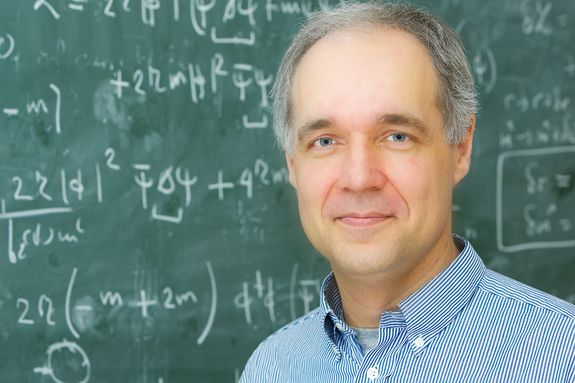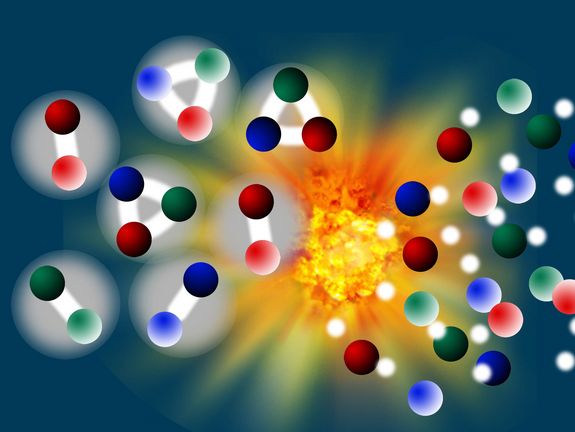Vienna (VUT). - Particle physics is is seeing revolutionary developments. Baffling connections are emerging between the physics of gravitation and the physics of elementary particles. With completely new methods scientists begin to unravel the strange properties of extremely hot states of matter that are being produced in laboratories such as CERN near Geneva.
At the Vienna University of Technology, Professor Anton Rebhan and his team are doing research on these topics, and he succeeded in bringing a number of the brightest brains in this field to a conference in Vienna.
Tiny particles, huge theories
Usually, the physics of elementary particles is formulated in terms of quantum field theories. In these theories, particles are pointlike objects, and at the same time they are described by oscillating fields permeating all of space. "Those theories are able to describe the behavior of elementary particles with enormous precision. But the success of quantum field theories is clouded by their failure to fully accommodate Einstein's theory of gravitation" says Prof. Rebhan. Since the seventies of the twentieth century, physicists have been working on string theories in the hope of eventually finding a theory of everything, fully uniting particle physics and gravity. In string theory, particles are no longer points without spatial extent, but associated to tiny vibrating strings, or multidimensional membranes. By this, string theory is able to accommodate a quantum theory of gravitation, but only in higher dimensions - that is with more than the three spatial dimensions that we see around us. Which is but one of the reasons for the immense mathematical complexity of string theory.
Particle physics as a hologram
String theory, which is extremely hard to deal with computationally, can - in some special cases - be reduced to a gravitational theory in five space-time dimensions. Surprisingly, in the geometrical constructions of those five-dimensional theories, physicists have found mathematical maps that represent all properties of strongly interacting quantum field theories in only four space-time dimensions (three space dimensions and one time dimension) - very much like holograms which give a complete picture of three-dimensional objects while being only two-dimensional themselves.
"It was found that theories that were originally developed to describe black holes and other gravitational phenomena could provide information on the interactions of elementary particles and vice versa" says Prof. Rebhan. So these theories are capable of making predictions for physical problems for which they have not been devised. This is as surprising as finding the required information for repairing a DVD player in some astronomy textbook. But indeed, it seems to work - the strange correspondence between string theories and quantum field theories is producing more and more results and predictions that can be put to test in experiments.
The most perfect fluid on earth
Prof. Rebhan is doing research on elementary particles in a particularly hot state, the quark gluon plasma, which was filling the entire universe a tiny fraction of a second after the Big Bang. Today quark gluon plasma can possibly be found in the interior of extremely dense stars, or in the collisions of atoms being smashed together at high energies in particle colliders such as the Relativistic Heavy Ion Collider RHIC (Brookhaven, New York) or the one at CERN (Geneva). In such collider experiments the quark gluon plasma was found to behave like an almost perfect fluid. The viscosity of this substance turned out to be much smaller than in any fluid that has been studied before, making the quark gluon plasma the most fluid substance on earth. Conventional methods of computation have failed to account for this phenomenon. "But it turned out that it was possible to relate properties like the viscosity to fluctuations of black holes", Prof. Rebhan explains. Again, gravitational physics provided the clue for calculations in particle physics, and lo and behold, the results agreed surprisingly well with measurements. By now, one also hopes that those connections between string theory and quantum field theories can be of help also in other areas of physics, for example to describe high temperature superconductors or the physics of ultracold atoms - and, indeed, this approach has produced some remarkable results already. Leading physicists from nuclear and particle physics meet string theorists in Vienna.
Open problems and questions of this new booming field of research will be discussed in the workshop "Hot Matter" that is to take place next week, from August 24 to 28 at the International Erwin Schrödinger Institute in Vienna, and which is part of a several weeks long research program "AdS holography and the quark gluon plasma". This program is being organised by Prof. Rebhan together with colleagues, two of which have begun their career at the Vienna University of Technology: String theorist Karl Landsteiner, who has been a professor at Madrid University since 2003, and Paul Romatschke, a shooting star of quark gluon plasma physics, who - after his doctoral studies with Prof. Rebhan – was working at the University of Washington, Seattle, before he recently moved to the Frankfurt Institute for Advanced Studies. (Romatschke was author of one of the decisive investigations of the viscosity of the quark-gluon plasma, which by now has become the most cited publication in theoretical nuclear physics of the past 5 years.) A number of leading experts will be coming to this workshop which is also supported by the German Helmholtz foundation. In total 70-80 scientists are expected to participate in the program, including representatives of two big experiments on the quark gluon plasma from RHIC and from CERN. It will be interesting what new surprises are in store for particle physics.
Photographs are available to download at: <link http: tuweb.tuwien.ac.at>
tuweb.tuwien.ac.at/index.php, opens an external URL in a new window
For more information please contact:
Vienna University of Technology
E136 - Institute for Theoretical Physics
Univ.Prof. Dipl.-Ing. Dr. Anton Rebhan
T +43-1-58801-13620
F +43-1-58801-13699
<link>rebhana@tph.tuwien.ac.at
<link http: www.itp.tuwien.ac.at rebhan>
www.itp.tuwien.ac.at/Rebhan, opens an external URL in a new window

